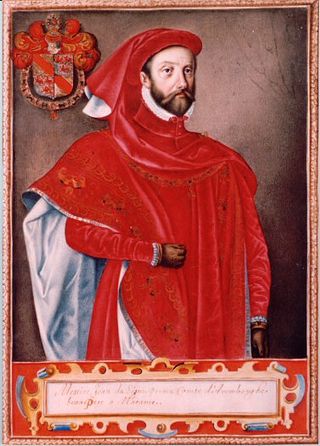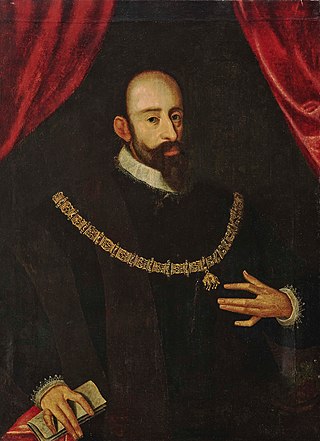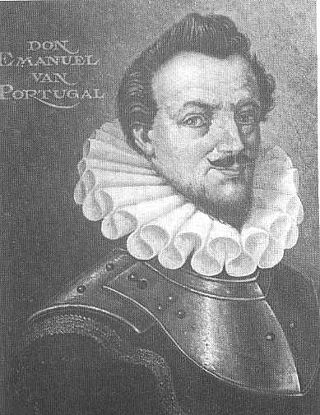Related Research Articles
The 1711 Sales Auction Catalogue of the Library of Sir Thomas Browne highlights the erudition of the physician, philosopher and encyclopedist, Sir Thomas Browne (1605-1682). It also illustrates the proliferation, distribution and availability of books printed throughout 17th century Europe which were purchased by the intelligentsia, aristocracy, priestly, physician or educated merchant-class.

Jean de Ligne, Duke of Arenberg was Baron of Barbançon, founder of the House of Arenberg and stadtholder of the Dutch provinces of Friesland, Groningen, Drenthe and Overijssel from 1549 until his death.

William V, called the Pious, was Duke of Bavaria from 1579 to 1597.

Margaret of Savoy was the last Habsburg Vicereine of Portugal from 1634 to 1640. In Portuguese she is known as Duquesa de Mântua, being by marriage the Duchess of Mantua and Montferrat. She was also regent of Montferrat during the minority of her daughter from 1612.

Ernest of Bavaria was Prince-elector-archbishop of the Archbishopric of Cologne from 1583 to 1612 as successor of the expelled Gebhard Truchsess von Waldburg. He was also bishop of Münster, Hildesheim, Freising and Liège.

The Life Guards was the senior formation of the King of France's Household Cavalry within the Maison militaire du roi de France.

The House of Arenberg is an aristocratic lineage that is constituted by three successive families that took their name from Arenberg, a small territory of the Holy Roman Empire in the Eifel region. The inheritance of the House of Croÿ-Aarschot made the Arenbergs the wealthiest and most influential noble family of the Habsburg Netherlands. The family's Duchy of Arenberg was mediatized in 1810. As such, the Arenbergs belong to the small group of families that constitute the Hochadel.

Aubert le Mire, Latinized Aubertus Miraeus was an ecclesiastical historian in the Spanish Netherlands.

Princely Count Charles of Arenberg, duke of Aarschot, baron of Zevenbergen, knight of the Order of the Golden Fleece, was the second Princely Count of Arenberg and a leading aristocrat of the Habsburg Netherlands, who served as a courtier, soldier, minister and diplomat.

Philippe-Charles d'Arenberg was the third sovereign prince of Arenberg and 6th Duke of Aarschot. He was a leading figure in the political life of the Spanish Netherlands.

Manuel of Portugal was the illegitimate son of António, Prior of Crato, pretender to the Portuguese throne during the 1580 Portuguese succession crisis. He secretly married in 1597 Countess Emilia of Nassau, daughter of William the Silent and Anna of Saxony.

John Francis Desideratus was count of Nassau-Siegen and stadtholder of Limburg and Upper Guelders.
Events from the 1580s in the Spanish Netherlands and Prince-bishopric of Liège.
References
- 1 2 Herbermann, Charles, ed. (1913). . Catholic Encyclopedia . New York: Robert Appleton Company.
- 1 2 3 4 5 6 J.-J. Thonissen, "Arenberg (Le P. Charles D')", Biographie Nationale de Belgique , vol. 1 (Brussels, 1866), 401-405.
- ↑ Volume 1 covering 1525-1580 and volume 2 1580-1612.